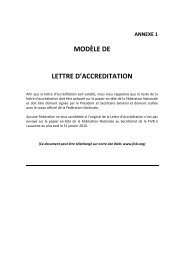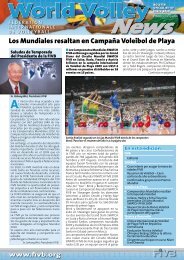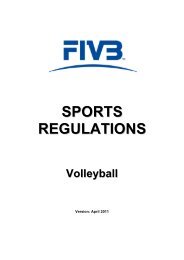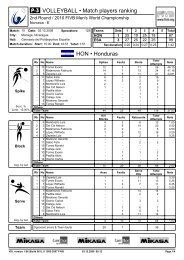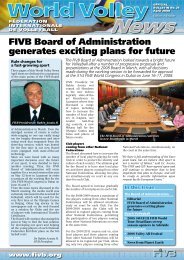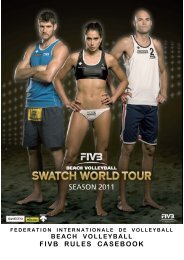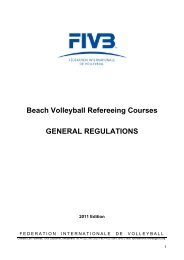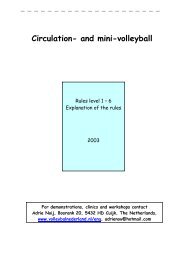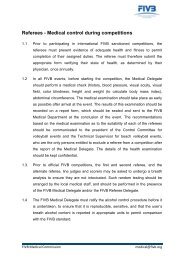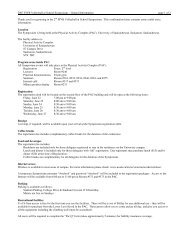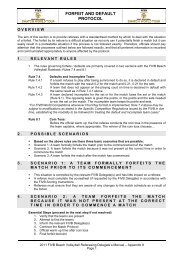Chapter 06 - TV Broadcasting Guidelines - FIVB
Chapter 06 - TV Broadcasting Guidelines - FIVB
Chapter 06 - TV Broadcasting Guidelines - FIVB
You also want an ePaper? Increase the reach of your titles
YUMPU automatically turns print PDFs into web optimized ePapers that Google loves.
<strong>Chapter</strong> 6<br />
<strong>TV</strong> <strong>Broadcasting</strong><br />
<strong>Guidelines</strong>
Post-match interview on center court<br />
6.1 Introduction<br />
Beach Volleyball is a perfect sport for television: it has all the<br />
ingredients to make a gripping television product thanks to its<br />
great athletes and exciting matches, providing superb action in the<br />
most beautiful resorts.<br />
<strong>FIVB</strong> has announced the new marketing and promotional initiative with<br />
the hero campaign at its core which intends to better involve our top<br />
players. The athletes are the heroes of the game. From this year onwards,<br />
the teams are propelled to the front row and shown as the brave men and<br />
women fighting for the victory. This project forms an important part of<br />
the re-branding of the <strong>FIVB</strong> and is meant to increase the popularity of our<br />
sport by placing the athletes as “heroes” on center stage.<br />
Therefore, in addition to the implementation of a new opening<br />
and closing sequence featuring the hero campaign, the Host<br />
Broadcaster will be expected to adapt its editorial line by giving<br />
more focus on the players, not only showing their match action but<br />
also more of their emotions so that the viewer can relate and feel<br />
every ounce of the player’s fear and determination. There will be<br />
more interviews, more close-ups, the feed will be decidedly more<br />
human and will offer a greater dimension.<br />
This section strives to standardize the necessary quality<br />
requirements of Beach Volleyball based on the widely acclaimed<br />
standard of the coverage introduced in Atlanta, and improved over<br />
successive Olympic Games.<br />
The 2011 <strong>FIVB</strong> Beach Volleyball SWATCH WORLD CHAMPIONSHIPS<br />
taking place in Rome are expected to be a reference for the <strong>FIVB</strong><br />
Beach Volleyball SWATCH WORLD TOUR season’s coverage.<br />
These <strong>Guidelines</strong> support the designated Host Broadcaster and the<br />
<strong>FIVB</strong> Letter of Agreement (Appendix E) signed in January, and which<br />
is part of the <strong>FIVB</strong> / National Federation Promoter Agreement.<br />
This chapter should be used in conjunction with the Host Broadcaster<br />
website http://www.fivb.org/en/tv/swatchworldtour/2011/, where<br />
further material can be found to support the Broadcast production<br />
implementation.<br />
worldwide with a consistent<br />
product throughout the season,<br />
irrespective of the event’s location,<br />
in order to maximize the exposure<br />
of the <strong>FIVB</strong> Beach Volleyball<br />
SWATCH WORLD TOUR. A positive<br />
working relationship with the Host<br />
Broadcasters, based on shared<br />
commitment, must be created in<br />
order to increase Beach Volleyball’s<br />
profile around the world. The <strong>FIVB</strong><br />
continues to revise the international<br />
television strategy focused on<br />
providing broadcasters with better<br />
Beach Volleyball coverage, which is<br />
initiated with a better <strong>TV</strong> production<br />
and optimized scheduling.<br />
It should be clearly understood at<br />
the outset that the Host Broadcast<br />
production is for the use of all <strong>FIVB</strong><br />
rights holders across the world. All<br />
Host Broadcast production must<br />
be impartial and not favour a specific team. For the production,<br />
you and your team are representing the <strong>FIVB</strong>, and your efforts<br />
and abilities should only be channeled into the Host Broadcast<br />
production. Therefore, the International Feed must take precedence<br />
over the Domestic Feed. Also, any unilateral production is to be<br />
produced with a separate crew and facilities.<br />
6.3 The Role of the <strong>TV</strong><br />
Coordinator and the <strong>TV</strong><br />
Coordination Agency<br />
<strong>FIVB</strong> has appointed IMG Media as the <strong>TV</strong> Coordination Agency in<br />
order to help Host Broadcasters with the understanding of the <strong>TV</strong><br />
production standard requirements and to assure that the International<br />
feed is distributed to the <strong>FIVB</strong>’s rights holding Broadcasters. As<br />
such, they oversee television related activities leading up to, during<br />
(on-site) and following the event, from the set-up of the television<br />
equipment to the actual production, broadcast and subsequent<br />
international distribution. They are also the liaison between HB and<br />
International rights holders during live transmissions.<br />
The <strong>FIVB</strong> <strong>TV</strong> Coordination Agency cannot perform its responsibilities<br />
unless the HBs complete their contractual obligations to broadcast<br />
matches in accordance with Beach Volleyball specifications and<br />
forward all communications concerning television matters to the<br />
<strong>TV</strong> Coordination Agency.<br />
After each event, the match footage will be reviewed to ensure<br />
that the expectations for all broadcasts are met, and suggestions<br />
may be made, to both HBs and Promoters, to further increase the<br />
quality of each production.<br />
The aims of the <strong>FIVB</strong> <strong>TV</strong> Coordination Agency are the following:<br />
– To work together with HB and National Federations in order to<br />
effectively implement the Television Broadcast plan.<br />
– To assist the <strong>FIVB</strong> by implementing a Television plan that works<br />
for both the National Host Broadcasters and International<br />
Broadcasters.<br />
– To ensure that the <strong>TV</strong> Production meets the minimum standards and<br />
respects the Television requirements related to Beach Volleyball.<br />
– To distribute the matches throughout the world.<br />
The President of the Polish Volleyball Federation Mr. Miroslaw Przedpelski, present at the Technical Meeting, an important step to coordinate <strong>TV</strong> activities<br />
6.4 The Organizers<br />
The Organizers retain total exclusivity of the domestic <strong>TV</strong> Broadcast<br />
rights for their territories as stipulated in the contract. They are<br />
required to secure a Host Broadcaster to produce and broadcast<br />
the event (or a <strong>TV</strong> Production Company and Domestic Broadcaster)<br />
in accordance with the <strong>FIVB</strong> regulations.<br />
The Organizers must secure <strong>TV</strong> coverage for their event through<br />
a domestic <strong>TV</strong> agreement for the benefits of promoting their<br />
event of the <strong>FIVB</strong> Beach Volleyball SWATCH WORLD TOUR, <strong>FIVB</strong><br />
Beach Volleyball SWATCH WORLD CHAMPIONSHIPS and Beach<br />
Volleyball in general. The Organizers must provide a high level<br />
of event organisation in order to guarantee a high quality event<br />
and solid partnership between all parties (in accordance with the<br />
<strong>FIVB</strong> agreement) and must comply with the broadcast regulations<br />
within the territory, and constantly meet all relevant deadlines. The<br />
Organizers must support the <strong>FIVB</strong> and the <strong>FIVB</strong> <strong>TV</strong> Coordination<br />
Agency where and when required.<br />
6.5 Inspection Visit and<br />
Meetings<br />
If a <strong>TV</strong> Inspection visit is deemed necessary by the <strong>FIVB</strong>, it must<br />
be scheduled no later than 2 months before the start of the event.<br />
During the <strong>TV</strong> inspection a meeting with the following participants<br />
must be held:<br />
– <strong>TV</strong> Coordinator<br />
– Interpreter (if required)<br />
– Promoter<br />
– Host Broadcaster Director and/or Producer<br />
– Representative of Technical Producer or Facilities Company<br />
Following this meeting the following forms have to be completed<br />
and returned to the <strong>FIVB</strong> and to the <strong>FIVB</strong> <strong>TV</strong> Coordination Agency<br />
within the set time period.<br />
WT 14 <strong>TV</strong> <strong>Broadcasting</strong> Intentions - 60 days before event<br />
6.6 Host Broadcaster<br />
Coverage - Match Scheduling<br />
The Television coverage for <strong>FIVB</strong> Beach Volleyball SWATCH WORLD TOUR<br />
events must be produced within the minimum standards set by the <strong>FIVB</strong>.<br />
As a minimum requirement for Open Events, the Host Broadcaster<br />
should guarantee that the following will be produced for all Men’s<br />
and Women’s events:<br />
– The semi-final matches<br />
– The final matches for 3 rd and 4 th place<br />
– The final matches for 1 st and 2 nd place<br />
– The awards ceremonies<br />
For all Grand Slam events, two quarter-final matches should also be<br />
produced, in addition to the above. However, the <strong>FIVB</strong> reserves the<br />
right to request production of up to four (4) additional matches, two per<br />
gender, based on the interest expressed by International broadcasters.<br />
For all above events, it is mandatory to implement a competition<br />
schedule in order to ensure a fully packed stadium for all televised<br />
matches. For instance, it is recommended that the semi-final matches<br />
should be scheduled on Saturday afternoon for single gender events<br />
while the finals should be played on Sunday afternoon. In case of<br />
staggered double gender events, the semi-final and final matches<br />
should be scheduled as either one of the two following examples:<br />
Friday Afternoon: Women’s semi-finals (or Men’s semi-finals)<br />
Saturday afternoon: Women’s finals (or Men’s finals)<br />
Men’s semi-finals (or Women’s semi-finals)<br />
Sunday afternoon: Men’s finals (or Women’s finals)<br />
Saturday afternoon: Women’s semi-finals (or Men’s semi-finals)<br />
Men’s semi-finals (or Women’s semi-finals)<br />
Sunday afternoon: Men’s finals (or Women’s finals)<br />
Women’s finals (or Men’s finals)<br />
For the <strong>FIVB</strong> Beach Volleyball SWATCH WORLD CHAMPIONSHIPS,<br />
eight matches per day should be produced, including all the semifinals<br />
and finals. It is understood that the post match interviews<br />
and the awards ceremony from the Final phase (both men’s and<br />
women’s) must be included within the matches produced.<br />
“In certain <strong>FIVB</strong> licenses, the domestic television broadcaster and<br />
producer are not identical. For the purposes of this Handbook, all<br />
references to ‘Host Broadcaster (HB)’ shall be deemed to cover any<br />
WT 15 <strong>TV</strong> Cameras Position Layout - 30 days before event<br />
‘Official Television Producer (OTP)’ and its associated production role The <strong>FIVB</strong> <strong>TV</strong> Coordination Agency provides a HB website where all<br />
These forms must be submitted even if a <strong>TV</strong> inspection is not held. Fully produced match coverage shall begin not less than 5 (five)<br />
and responsibilities.”<br />
involved parties can download coordination forms, camera plans<br />
minutes prior to the start of each match and end not less than 3<br />
and other useful information. Do not hesitate to contact the <strong>TV</strong><br />
The day before the first transmission at each event, a general (three) minutes after the last point of each match.<br />
6.2 Aims and Objectives<br />
Coordination Agency whenever there is a question, problem or any<br />
confusion. Please send your email to <strong>FIVB</strong>.<strong>TV</strong>Agency@imgworld.com.<br />
briefing meeting must be held with the <strong>FIVB</strong> Technical Supervisor,<br />
the Host Broadcaster, the Referee Delegate, the Official Announcer<br />
and the <strong>TV</strong> Coordinator on-site. The main television aspects<br />
WT 14 <strong>TV</strong> <strong>Broadcasting</strong> Intentions - 60 days before event<br />
The Broadcast Manager is your first point of call for all television<br />
(including but not limited to match start times, timings in between<br />
The <strong>FIVB</strong> goal is to continue to raise the standard coverage queries. And at the event, there will be a <strong>TV</strong> Coordinator on-site.<br />
matches, post gold match interviews and medal ceremony etc.) as When completing WT 14, please ensure that you clearly indication<br />
requirements for Beach Volleyball and provide broadcasters<br />
well as its coverage must be reviewed in detail.<br />
the actual times the Domestic Broadcaster will be broadcasting<br />
154 155<br />
<strong>TV</strong> <strong>Broadcasting</strong> <strong>Guidelines</strong> 6
Beach Volleyball programming, specifying which matches will be<br />
included in the programming.<br />
If a Domestic Broadcaster wants to broadcast more matches than<br />
the minimum production commitment this of course is acceptable<br />
and encouraged. The <strong>FIVB</strong> would look at making these available<br />
to the International rights holders too, so please discuss the<br />
Domestic Broadcast requirements with the <strong>FIVB</strong> <strong>TV</strong> Coordination<br />
Agency so an optimum broadcast schedule can be arranged to suit<br />
all: Promoter, Domestic and International Broadcasters.<br />
The competition schedule must be finalized by the Promoter<br />
two months before the event.<br />
Once a competition schedule has been set, any modification (as<br />
supplied in WT 14) requires written approval by the <strong>FIVB</strong> and the<br />
<strong>FIVB</strong> <strong>TV</strong> Coordination Agency. Due to the <strong>FIVB</strong>’s commitments<br />
to their International Broadcasters, timings must follow the<br />
Competition Schedule so that Satellite distribution is not changed.<br />
Moreover, when two televised matches follow each other and the first<br />
one “under-runs”, the second one will start on the following hour. If a<br />
match “over-runs”, the following match will start as soon as possible<br />
after the end of the previous match (after the score sheet is signed).<br />
I. e. it will start as soon as possible its Official Protocol and following<br />
that, the International feed will be produced as per the running order.<br />
If the Promoter schedules a non-televised match between two<br />
televised matches, then the Promoter will allow at least 1h30min<br />
before the start of the televised match so that the broadcasters<br />
are not confused. Promoters can schedule a non-televised match<br />
only during semi-final matches. Non-televised matches will not be<br />
scheduled around bronze and gold medal matches.<br />
6.7 Host Broadcaster<br />
Coverage - Obligations<br />
The following obligations must be provided by the Host Broadcaster<br />
for the sole use in producing the <strong>FIVB</strong> International feed.<br />
In case a tournament is suspended or stopped (upon the <strong>FIVB</strong><br />
Technical Supervisor’s decision) the Host Broadcaster must<br />
guarantee the coverage of matches that may be played on an extra<br />
day. For all Events, the Host Broadcaster must make best efforts to<br />
record additional material in case of cancellation of matches due to<br />
weather conditions or injuries.<br />
The minimum camera requirements are as follows:<br />
– Open Events<br />
Camera 1 to 6, including 1 Slow-motion camera and 1 Crane<br />
camera.<br />
An ENG crew filming outside the fields of play<br />
– Grand Slam Events<br />
Camera 1 to 8, including 1 super Slow-motion and 1 Crane<br />
camera.<br />
– <strong>FIVB</strong> Beach Volleyball SWATCH WORLD CHAMPIONSHIPS<br />
Camera 1 to 10, including 1 super Slow-motion, 1 Crane camera<br />
and 1 specialist camera.<br />
Regarding the ENG requirements, for all events (including the<br />
<strong>FIVB</strong> Beach Volleyball SWATCH WORLD CHAMPIONSHIPS), a<br />
full broadcast standard ENG crew (digital beta 625 or 525 SDI<br />
16:9) shall be available free of charge to the <strong>FIVB</strong>, <strong>TV</strong> Coordinator<br />
and <strong>FIVB</strong>’s Highlights production team, separate from the Host<br />
Broadcast operation, for use on the Highlights programming<br />
including but not limited to match footage, player interviews, event<br />
atmosphere, gathering scenic shots, etc.<br />
The ENG crew (and full digital equipment) should be available for 8<br />
hours per day, with the following number of days being required for<br />
each category of event:<br />
Single gender Open events: One (1) day of use;<br />
Double gender Open events: Two (2) days of use;<br />
Double gender Grand Slam events: Three (3) days of use;<br />
<strong>FIVB</strong> Beach Volleyball SWATCH<br />
WORLD CHAMPIONSHIPS: Seven (7) days of use.<br />
The exact dates that the ENG crew will be required will be advised<br />
to the Host Broadcaster by the <strong>FIVB</strong> <strong>TV</strong> Coordination Agency or<br />
<strong>FIVB</strong> Highlights Production team at least 7 days in advance of the<br />
event.<br />
The Highlights team will provide a producer to work with the ENG<br />
crew provided by the Host Broadcaster, which should include the<br />
following personnel in addition to the equipment:<br />
– Cameraman<br />
– Audio Technician<br />
For the <strong>FIVB</strong> Beach Volleyball SWATCH WORLD TOUR events,<br />
the delivery of the International Feed must be made in Standard<br />
Definition 16:9 (4:3 graphics safe), with English commentary and<br />
without any domestic content. The News Feed must be treated in<br />
the same way as the International Feed.<br />
For the <strong>FIVB</strong> Beach Volleyball SWATCH WORLD CHAMPIONSHIPS,<br />
the delivery of the International Feed must be made in High<br />
Definition 16:9 (4:3 graphics safe), with English commentary<br />
when required and without any domestic content. <strong>FIVB</strong> and its <strong>TV</strong><br />
Coordination Agency will have the possibility to ask for Standard<br />
Definition 16:9 (4:3 graphics safe) if required.<br />
If the Domestic Broadcaster wishes to access the International<br />
Feed from the <strong>FIVB</strong>’s satellite, they should contact the <strong>FIVB</strong> <strong>TV</strong><br />
Coordination Agency for details.<br />
6<br />
6.8 Technical and Production<br />
Specifications<br />
A. Generalities<br />
The equipment used on <strong>FIVB</strong> Host Broadcast productions must be of<br />
full broadcast quality specification, regularly maintained and serviced.<br />
<strong>Broadcasting</strong> formats across the world vary considerably, and<br />
are constantly changing and being upgraded. The 2008 Beijing<br />
Olympics produced all their transmissions in High Definition, and<br />
this standard will in time become the “normal” requirement for<br />
<strong>FIVB</strong> Host Broadcasts. For the 2011 season, the production format<br />
for the <strong>FIVB</strong> Beach Volleyball SWATCH WORLD TOUR events is 625<br />
Pal SDI 16:9 or in certain territories of the world 525 NTSC SDI<br />
16:9. It is acceptable for the Host Broadcast to be produced in High<br />
Definition but they must provide a Standard Definition signal to the<br />
<strong>FIVB</strong>’s SNG truck on-site.<br />
However, the production format for the <strong>FIVB</strong> Beach Volleyball SWATCH<br />
WORLD CHAMPIONSHIPS is 625 Pal HDI 16:9 and will be made<br />
available to the International Broadcasters in the same format (except<br />
if SD 16:9 is required by the <strong>FIVB</strong> and its <strong>TV</strong> Coordination Agency).<br />
The Host Broadcast productions must keep all relevant action<br />
within the 4:3 “safe” area on screen, and all graphics will be<br />
designed to fit inside the 4:3 area.<br />
All tape recordings for the <strong>FIVB</strong> must also be in Standard Definition<br />
(digital betacam with time of day timecode). It is up to the Host<br />
Broadcaster to convert the signal and tape recordings to Standard<br />
Definition at their own cost.<br />
4<br />
<strong>TV</strong> Camera Positions<br />
2<br />
9<br />
7<br />
1<br />
10<br />
3<br />
B. Camera positions<br />
The following cameras and camera positions are to be utilised for<br />
all <strong>FIVB</strong> Host Broadcast Productions. The <strong>FIVB</strong> Television Manual<br />
shows examples of these camera positions and usage.<br />
A minimum of 6 cameras should be used for Open events (cameras<br />
1-6), a minimum of 8 cameras for Grand Slam events (cameras<br />
1-8) and a minimum of 10 cameras for the <strong>FIVB</strong> Beach Volleyball<br />
SWATCH WORLD CHAMPIONSHIPS (cameras 1-10). If additional<br />
cameras are planned to be used, this should be discussed with the<br />
<strong>FIVB</strong> and the <strong>FIVB</strong> <strong>TV</strong> Coordination Agency.<br />
Camera No. Lens Operation<br />
1 14x Coverage / Replay camera on platform<br />
2 55x Close up camera on platform<br />
3 11x Handheld camera<br />
4 11x Handheld camera<br />
5 11x Coverage / Replay Crane camera<br />
6 55x Low angle slow motion camera<br />
7 w/a Net camera<br />
8 11x High mounted camera<br />
9 11x Hand held wireless camera<br />
10 w/a Specialist camera<br />
Height of cameras (platforms) to be confirmed once style of<br />
spectators stands (seating bowl) is confirmed by the Promoter,<br />
following the guidelines below. Promoter will need to provide the<br />
graphic design for the spectator stands so exact camera placing<br />
can be confirmed.<br />
156 157<br />
5<br />
8<br />
<strong>TV</strong> <strong>Broadcasting</strong> <strong>Guidelines</strong> 6
An example of camera one and two Camera 3 (handle camera) catching players emotions<br />
Camera one<br />
Camera one should be placed on the opposite side of the arena to<br />
the main public stands, to show the major section of crowd, behind<br />
play and during a match. The ideal position is for the camera to be<br />
at a point 30m back and at an angle of 30 degrees from the centre<br />
of the court. The camera should be offset by 1-2m to the left of<br />
centre, so the face of the net can be seen. It will generally require<br />
a scaffold platform, set-up separately from the VIP stands to avoid<br />
shaking. The positioning of the roof covering the VIP tribune must<br />
take into consideration the main camera’s angle and should be put<br />
at a reasonable distance above the spectators. This camera is used<br />
for some of the main coverage and is a main replay angle.<br />
Camera two<br />
The ideal position for camera two is offset to the right of the net,<br />
below camera one. However, it is often difficult to obtain this<br />
ideal position, so the always achievable position on the platform<br />
alongside camera one is acceptable. This is used as a main close up<br />
camera, and for replay coverage during play.<br />
Cameras three and four<br />
The cameras three and four must be on court and used handheld.<br />
They should be used for close ups of players before and after points<br />
and provide coverage for replay purposes during play. They should<br />
also be used during time-outs with built-in microphones to show and<br />
hear the players on the bench. A cable assistant during the production<br />
operations is necessary to avoid any problems or disturbances. If<br />
possible these cameras should be of wireless operation to alleviate<br />
the need for cable or a camera assistant on the court area.<br />
If there is a need for a ‘seat’ for the cameramen it must not be hard<br />
material and the location must be agreed with the <strong>FIVB</strong> Technical<br />
delegate and <strong>FIVB</strong> <strong>TV</strong> Coordinator no later than 3 hours prior to the<br />
first televised match.<br />
Camera five<br />
The crane camera is considered by many to be the best and most<br />
dynamic camera for main coverage. It should be at least 6m in<br />
length, positioned at the end of the court not facing the sun, with a<br />
good operating area around its base. It is essential an experienced<br />
crane camera operator is employed in order to optimize the use<br />
of the camera. This camera is absolutely crucial to provide good<br />
Beach Volleyball coverage and is recommended to be used as the<br />
main live camera during play for the majority of points.<br />
Camera six<br />
The camera is on a tripod in the low end zone located on the<br />
opposite end from the crane camera. This camera is mainly used<br />
for reaction shots, players signals, set up shots before a service,<br />
and for replays. This should be a super slow motion (SSM) camera<br />
for all events.<br />
Camera seven<br />
A net camera (CCD Megapixel Mini camera minimum) must be fixed<br />
at the top of the net post offset to the right of the net. It will be used<br />
for set up shots and replays. The <strong>FIVB</strong> Technical Supervisor must<br />
be consulted in order to determine the exact positioning of the net<br />
camera. This Camera must be installed no less than 3 hours prior<br />
the start of the first match on court. All cabling must be out of sight.<br />
Camera eight<br />
The camera should be located to capture the entire complex,<br />
including the surrounding beaches, crowds on the beach, and<br />
general atmosphere shots at the venue. If it is manned it can<br />
provide some good alternate angles for replay use.<br />
Camera nine<br />
A handheld camera that works in the public stands showing the<br />
atmosphere generated at the venue. For ease of movement to<br />
obtain the best shots this should be a wireless camera.<br />
Camera ten<br />
Camera ten can be used in a variety of locations. As a fixed<br />
camera it can work high in the stands at the opposite end of court<br />
from the crane. Recent <strong>FIVB</strong> Beach Volleyball SWATCH WORLD<br />
CHAMPIONSHIPS have successfully used a wire cam across the<br />
venue. Other Grand Slam events have had access to a helicopter<br />
shot. Other options for placement may be available such as on a tall<br />
building overlooking the whole venue.<br />
cable camera<br />
The <strong>TV</strong> Coordinator may advise the Host Broadcaster on the best<br />
location to place the cameras during the on-site visit. The proposed<br />
camera positions must be sent to the <strong>TV</strong> Coordination agency,<br />
with a copy to <strong>FIVB</strong>, for approval a minimum 30 days before start<br />
of the tournament (WT/15 form). The layout must clearly show the<br />
distances of the cameras from the court as well as the height in<br />
relation to the playing court.<br />
If additional visible materials such as umbrellas are used,<br />
they should all be the same so that there is uniformity. Also,<br />
cameramen and assistant operators should use bibs (possibly of<br />
a darker colour) so that they can be recognized as the official Host<br />
Broadcaster of the event.<br />
<strong>TV</strong> Innovations for the<br />
Future of the Sport !<br />
158 159<br />
<strong>TV</strong> <strong>Broadcasting</strong> <strong>Guidelines</strong> 6
An appropriate placement of microphones facilitate the production of a good <strong>TV</strong> product<br />
C. Audio<br />
For all recordings and satellite transmissions, the following audio<br />
configurations should be used.<br />
Track one Stereo Full English commentary & International<br />
sound mix (Left)<br />
Track two Stereo Full English commentary & International<br />
sound mix (Right)<br />
Track three Stereo International Sound (Music & effects) (Left)<br />
Track four Stereo International Sound (Music & effects) (Right)<br />
Tracks three and four must only contain the clean International<br />
ambient sound from the court and any <strong>FIVB</strong> cleared music from<br />
the programme. International sound refers to the audio from<br />
the stadium, the ball being hit by players, the players’ noise, the<br />
crowd’s noise, the public address system and music, the referee’s<br />
whistle and/or instructions, etc.<br />
The sound levels of the public address system and music should<br />
be carefully controlled as they strongly affect the loudness of the<br />
international sound. Music and commentary should be played<br />
during court changes and time-outs only and never during rallies<br />
due to the intricacy to edit pictures at that time for the broadcaster.<br />
Copyright problems may also occur if commercial music is heard<br />
as a background noise. Likewise, commentaries via the public<br />
address system on the international sound track should not be<br />
audible as they may conflict<br />
with the commentary on track<br />
one. Microphones should<br />
be strategically positioned<br />
to ensure the clearest and<br />
best possible audio signals<br />
featuring:<br />
– the players’ body contact with<br />
the ball<br />
– the players’ discussions on<br />
court and during time outs<br />
– the crowd’s close-up<br />
applause and general<br />
excitement surrounding the<br />
event<br />
– the public’s reaction to the<br />
players’ performance<br />
– the referees’ calls<br />
It is the responsibility of the <strong>FIVB</strong> to provide an English language<br />
commentator on-site for each event. This commentary will be used<br />
on the live transmission by some international broadcasters, as a<br />
guide commentary by others, and will be required for the highlights<br />
programming. The guide commentary provides international<br />
broadcasters with a play-by-play account in English of the key<br />
action during a match. International Broadcasters, can also record<br />
a commentary in their own language, using the English guide<br />
commentary as a basis.<br />
A suitable commentary position for the Host Broadcast<br />
commentary must be supplied. It should be located on the same<br />
side of court as the main camera positions, be large enough for<br />
three people and have two commentary control units including<br />
two headsets (the extra headset being for the possible use of a cocommentator)<br />
and associated monitoring.<br />
Please remember it is the responsibility of the Host Broadcaster to<br />
provide Talk Back to the English commentator. The HB must advise<br />
the commentator when the match is starting, when the director is<br />
going to cut to the city shots, throw to the Flash Interview and close<br />
the programme.<br />
Incidental music will be supplied by the <strong>FIVB</strong> <strong>TV</strong> Coordination<br />
Agency, cleared for worldwide transmission, which should be used<br />
with any full page graphics (e.g. set statistics) and as background<br />
to any set or match action montages.<br />
Microphones Positions<br />
FIXED MICROPHONES<br />
PERSONNEL MICROPHONES<br />
Around 20 microphones should<br />
be used to capture these audio<br />
effects. Personnel microphones<br />
should be used on the referee<br />
and on the net. All placements<br />
must be discreet from all<br />
camera shots.<br />
An experienced <strong>FIVB</strong> Player, Mr. Hoidalen (NOR) assisting the<br />
<strong>FIVB</strong> Official <strong>TV</strong> commentator An example of a SNG truck and its operations around it<br />
160 161<br />
<strong>TV</strong> <strong>Broadcasting</strong> <strong>Guidelines</strong> 6
Screen shots of <strong>FIVB</strong> transition wipe<br />
D. Graphics<br />
All <strong>TV</strong> graphics and relevant data will be provided live for free onsite<br />
to each Host Broadcaster by Swiss Timing. In accordance with<br />
the Host Broadcaster Letter of Agreement, each Promoter and<br />
Host Broadcaster must ensure that the following equipment will be<br />
available before each production:<br />
– 1 coaxial cable for negative synchronization pulses -0,3v and<br />
burst at 75 ohms (black burst).<br />
– 1 power line - 230v / 4A (optional).<br />
– 1 coaxial cable for output color Signal pal / ntsc or sdi.<br />
– 1 coaxial cable for final image.<br />
– 1 color monitor for program.<br />
– 1 intercom Connection with two sets.<br />
– 1 coaxial cable for output key signal 625, 525 or sdi.<br />
– 1 coaxial cable for animation preview color Signal PAL / NTSC or SDI.<br />
Matches for the International feed must be broadcast complete<br />
with <strong>FIVB</strong>-approved international graphics in their entirety and free<br />
of any commercial or broadcaster identification.<br />
Examples of the graphics style and a guide to implementation<br />
in the Host Broadcast can be found on the broadcast website -<br />
http://www.fivb.org/en/tv/swatchworldtour/2011/ and <strong>FIVB</strong>’s <strong>TV</strong><br />
Manual. This latter can be provided to the interested parties upon<br />
request.<br />
E. Replay Record and Use<br />
The use of a replay, in a quick moving sport such as Beach<br />
Volleyball, is vital to fully visualize the skill, speed and precision of<br />
the play. Equally important is that no live action should be missed.<br />
In order to coordinate actions between the <strong>TV</strong> Director and the 1 st<br />
Referee, the 1 st Referee must be advised when a replay is being<br />
transmitted. This can be done in either of two ways:<br />
– The Paddle System: The Floor Manager sits on the opposite side<br />
of the court to the 1 st referee and using a Paddle, indicates to the<br />
referee when a replay is being broadcast - one side is Red, to<br />
indicate to the referee to stop play, and the other side Green to<br />
indicate to the referee to continue play.<br />
– The Talk Back System: Equip the 1 st Referee with an earpiece so the<br />
Director/Producer can call to the referee to "hold play" if required.<br />
Whichever system is used, this privilege should not be abused and<br />
is suggested that play should not be held by more than 6 times a<br />
set and then for not more than 7 seconds. A clear understanding<br />
and cooperation is needed between the producer and 1 st referee for<br />
this to work well.<br />
A short replay <strong>FIVB</strong> transition wipe will be supplied by the <strong>FIVB</strong> for<br />
use between live action and relays. This should be used only during<br />
live play, and any replays shown during time outs, between sets or<br />
at the end of play should be transitioned into by use of a dissolve.<br />
The use of replays in the Host Broadcast should be decided upon,<br />
keeping in mind the philosophy that the replay must add to the<br />
production coverage. Alternate angles of play and unseen reactions<br />
are key sources of replay. All cameras should be recorded for<br />
F. International Feed<br />
HB will produce the Basic Feed and the International Feed of the<br />
Competition by supplying a first-class, top-quality colour signal<br />
with international sound (with the International Feed being totally<br />
devoid of any added commercial material and with no in-vision<br />
presenters, or studios or any other local or customized features,<br />
for international transmissions).<br />
The production of the Basic Feed and the International Feed extends<br />
to all authorized sites and all matches to be played throughout the<br />
competition, according to the technical regulations governing it.<br />
For the <strong>FIVB</strong> Beach Volleyball SWATCH WORLD TOUR events,<br />
the International Feed will be made available to <strong>FIVB</strong>, its <strong>TV</strong><br />
Coordination Agency, and to all International Broadcasters in<br />
Standard Definition 16:9 (4:3 safe) format with cleared English<br />
commentary and international graphics on-site at HB’s SNG<br />
truck on a free of charge basis. The Host Broadcast is encouraged<br />
to produce a signal in High Definition but must also provide a<br />
Standard Definition signal to the <strong>FIVB</strong>’s SNG truck on-site. For<br />
the <strong>FIVB</strong> Beach Volleyball SWATCH WORLD CHAMPIONSHIPS, the<br />
format required is High Definition 16:9 (4:3 safe), <strong>FIVB</strong> and its <strong>TV</strong><br />
Coordination Agency will have the possibility to ask for Standard<br />
Definition 16:9 (4:3 graphics safe) if required.<br />
For the avoidance of the doubt, HB shall provide, at its sole cost,<br />
the SNG on-site for each day of the Event included in the production<br />
obligation. For the <strong>FIVB</strong> Beach Volleyball SWATCH WORLD<br />
CHAMPIONSHIPS, the SNG will be HD capable. <strong>FIVB</strong> and the <strong>FIVB</strong><br />
<strong>TV</strong> Coordination Agency will be responsible for the satellite up-link.<br />
HB will pencil the SNG eight weeks prior to the event and confirm<br />
the SNG four weeks prior to the event. If the HB has not confirmed<br />
the SNG booking four weeks prior to the Event, then <strong>FIVB</strong> will<br />
manage directly the booking of the SNG and will charge HB the<br />
total incurred cost connected thereto.<br />
And finally, <strong>FIVB</strong> will provide the English Commentary and<br />
international graphics for insertion by the HB into the International<br />
Feed.<br />
2011 <strong>TV</strong> graphics: teams statistics<br />
G. Recording, Melt Reels and News Feed<br />
RECORDINGS<br />
All matches, including the World Championship matches, should<br />
be recorded in Standard Definition onto new (unused) Digital beta<br />
tapes with time of Day timecode for use by the <strong>FIVB</strong>’s Highlights<br />
Programmes, delayed tape recording for International Broadcasters<br />
and the Archive. No play must be missed and there is to be at least<br />
a 2 minute overlap on each tape, when changing tapes.<br />
One complete Digital beta copy and two DVD recordings of each<br />
match, to be made available to the <strong>TV</strong> Coordinator immediately<br />
after each match to be checked.<br />
The audio configuration should be as follows:<br />
Track one Stereo Full English commentary & International<br />
sound mix (Left)<br />
Track two Stereo Full English commentary & International<br />
sound mix (Right)<br />
Track three Stereo International Sound (Music & effects) (Left)<br />
Track four Stereo International Sound (Music & effects) (Right)<br />
MELT REELS<br />
At the end of a match, a selection of the best replays and close up<br />
reaction shots should be copied from the hard disc recorders onto<br />
the end of the master archive tapes, free of any graphics, to provide<br />
a “melt reel” from that match. This material should be selected<br />
on quality rather than quantity, but contain all the best play and<br />
reactions from different camera angles.<br />
All master tapes should be labeled, both on the tape itself and on the<br />
outside of the box, and contain a basic log of contents. The design<br />
for the tape labels and logs can be downloaded from the broadcast<br />
website http://www.fivb.org/en/tv/swatchworldtour/2011/.<br />
Then one digital beta copy to go to the Highlights Production team<br />
and the other is to be shipped by the Host Broadcaster to the <strong>FIVB</strong><br />
Archive Department by DHL or a similar standard courier service to:<br />
Mr. Filippo Guidolin<br />
IMG Media<br />
McCormack House<br />
Burlington lane<br />
London W4 2TH Office: +44 (0) 208 233 6140<br />
United Kingdom Filippo.Guidolin@imgworld.com<br />
NEWS FEED<br />
At the end of each day’s transmission, a 5 minute news package<br />
should be produced and played out on the satellite no more than 15<br />
minutes after the end of the main programming. It should include<br />
a venue establishing shot, key match points, a selection of good<br />
points featuring both teams, and any celebrations and awards. A list<br />
of suggested shots for the news feed can be found on the broadcast<br />
website http://www.fivb.org/en/tv/swatchworldtour/2011/.<br />
2011 <strong>TV</strong> graphics: weather conditions<br />
H. Monitors and Communication<br />
The following positions must be provided with a monitor showing<br />
the programme output by the Host Broadcaster on-site to the<br />
following positions.<br />
– 1 x <strong>TV</strong> Production / Event Office.<br />
– 1 x Court Announcer.<br />
– 1 x On Court (opposite side to the referee to enable the floor<br />
manager to provide the 1 st referee with hand signals if needed).<br />
For better communication, the <strong>TV</strong> coordinator must be equipped<br />
with a radio set by the Host Broadcaster during the production and<br />
recording times. The line of communication during production must<br />
be as follows: <strong>TV</strong> Director, Production Manager, <strong>TV</strong> Coordinator,<br />
<strong>FIVB</strong> Technical Supervisor, Referee Delegate and Promoter. The<br />
Host Broadcaster, Domestic Broadcaster and all International<br />
Broadcasters’ first point of contact should always be the <strong>TV</strong><br />
coordinator on-site.<br />
If not using the Paddle System for replays, the 1 st referee must be<br />
supplied with a switchable Talk Back from the replay producer to<br />
enable the replay through the earpiece system to work at its fullest<br />
potential.<br />
In the case that there is a large screen that can be seen by spectators<br />
and players inside the court, there must be a feed distribution point<br />
at the technical supervisor’s area, so the action can be cut from the<br />
screen if required.<br />
replay use. An International Referee equipped with an earpiece A referee continuing the action thanks to the earpiece<br />
162 163<br />
<strong>TV</strong> <strong>Broadcasting</strong> <strong>Guidelines</strong> 6
Post-match interviews in front of the official competition backdrop<br />
I. Power and Lighting<br />
All power for the Host Broadcast should be uninterrupted and on<br />
a different phase from the rest of the stadium power. There should<br />
be “back up” power available for the Host Broadcast production<br />
facilities, which will automatically activate in the event that the<br />
“main” power should fail. This should be synchronous, and not in<br />
any way disrupt the production signal.<br />
The Host Broadcaster should consult the local promoter and the<br />
National Federation in order to guarantee the proper orientation of<br />
the court, taking into consideration the position of the sun in relation<br />
with the main cameras. The following principles should be observed:<br />
– The main <strong>TV</strong> cameras must not face the sun.<br />
– Shadows on court must be monitored during the entire day in<br />
order not to affect the broadcast as well as the production quality.<br />
Should the Host Broadcaster encounter difficulties regarding<br />
the proper orientation of the court, the <strong>TV</strong> Coordinator must be<br />
informed immediately.<br />
If play is to take place at night, the stadium should be lit to an<br />
acceptable broadcast standard, without any shadows or patches<br />
across the playing area. As a general rule the average illumination in<br />
the vertical plane should be 1500 lux across the playing surface and<br />
immediate surrounds, with the crowd areas lit to approximately 1000<br />
lux. All interview areas must have acceptable independent lighting.<br />
J. Interviews<br />
To further enhance the programmes’ editorial content, a "flash<br />
interview" is required for television only. It will enable the<br />
worldwide broadcasters to have a winners’ interview after each<br />
televised match. This "flash interview" should be organised during<br />
the end of match formalities (see running order) and should not<br />
exceed one minute.<br />
Shadow analysis<br />
The sequence of events should be as follows:<br />
– After initial celebrations and signing score sheet, winning team or<br />
a representative player of the winning team (preferably an English<br />
speaker) will be asked to answer one or two short questions on<br />
court.<br />
– Following the end of transmission, another interview will be<br />
conducted on court with the winning team/a player from the<br />
winning team both in English and their native tongue in order to<br />
maximise the material for editing the highlight programme.<br />
Any <strong>FIVB</strong> HB interview must take priority over any unilateral<br />
interview. If a rights holder wants an interview they need to advise<br />
the <strong>TV</strong> coordinator and Press officer and be guided to the Mixed<br />
Zone. If the rights holder is after a live interview, it must be done<br />
after the <strong>FIVB</strong> interview, it must not be in view of the International<br />
Feed cameras. And if the domestic HB wants an Interview, it must<br />
not be within the International programme.<br />
6.9 <strong>TV</strong> Program Rundown<br />
Each transmission must follow the described sequence as set out in the following running orders for broadcasting needs pre and post match,<br />
and between sets. This is essential to allow all broadcasters taking the feed to know points where they can enter and exit the Host Broadcast.<br />
For each televised match, the <strong>TV</strong> transmission will start on the hour and the first serve will start 5 minutes after the hour, just when the 10<br />
minute Official Match Protocol ends. In case there is an "over-run", the following match will start as soon as possible after the end of the<br />
previous match. If a match "under-runs", it will start on the following hour (see Point 6.6).<br />
Countdown<br />
to first serve<br />
Duration Activity on Court Video Graphic<br />
-18:00 5´ START OF INTERNATIONAL SATELLITE LINE-UP (Technical Checks)<br />
Match Description, Clock<br />
-05:30 30" START OF INTERNATIONAL FEED Countdown clock<br />
-05:00 30" Players Warm-Up; <strong>FIVB</strong> Titles Sequence None<br />
-04:30 10” Players Official Warm-Up and Preparations Wide shots Event Title<br />
-04:20 30” Players Official Warm-Up and Preparations General scenic pictures<br />
of Host City<br />
-03:50 10” Players Official Warm-Up and Preparations General pictures of venue,<br />
crowd atmosphere<br />
Match Graphics<br />
(Semi-Final X vs Y)<br />
-03:40 10” Players Official Warm-Up and Preparations Wide Shot of Stadium Weather Graphic<br />
-03:30 2’ 00” Players Official Warm-Up and Preparations<br />
(- 02:00 End of Official Warm-Up & Preparations<br />
– Players go to bench;<br />
– Referees taking their stands);<br />
-01:30 15” End of Official Warm-Up & Preparations<br />
– Players go to bench;<br />
– Referees taking their stands;<br />
Shots of players, crowd,<br />
atmosphere<br />
Presentation to crowd<br />
of 1 st Referee<br />
4 x individual Players Name-<br />
Graphics<br />
(long form)<br />
Graphic 1 st & 2 nd Referee +<br />
name<br />
-01:15 30” Players on bench and then enter the court Presentation Team 1 2 x individual Players Name-<br />
Graphics (short form)<br />
-00:45 30” Players on bench and then enter the court Presentation Team 2 2 x individual Players Name-<br />
Graphics (short form)<br />
-00:15 15” Players final check and prepare for first serve General shots and Closeups<br />
of players<br />
-00:00 First Whistle Start of the Match Match graphics<br />
BETWEEN SETS<br />
01:00 End of set Player close ups Match result summary<br />
As needed Court sweep Wide shots<br />
As needed Court sweep Set montage/highlight None<br />
As needed Court sweep Wide shots<br />
As needed Venue clear Player close ups<br />
-00:00 Venue clear Start of set Match graphics<br />
END OF MATCH<br />
00:00 Emotions, Teams shake hands at net,<br />
Teams shake hands with Referees<br />
Match highlights<br />
None<br />
End of match formalities Match result summary<br />
-01:30 20" Players leave court General shots Match result summary<br />
-00:30 30” Venue clear <strong>FIVB</strong> Titles Sequence<br />
-00:00 Venue clear End of Transmission<br />
BETWEEN MATCHES - in the same ‘session’ of televised matches<br />
00:00 05’ At the end for the Match the Referees will<br />
start the 10 minute protocol which runs<br />
up to the first serve.<br />
Continuous and usable for<br />
broadcast, wide angle of<br />
the stadium<br />
-05:00 Start International feed<br />
with <strong>FIVB</strong> Titles sequence.<br />
Do not use countdown clock<br />
END OF GOLD MEDAL MATCH<br />
00:00 Emotions, Teams shake hands at net,<br />
Teams shake hands with Referees<br />
End of match formalities<br />
asap Flexible "Flash Interview" English winning team interview<br />
20" Players leave court General shots<br />
30” <strong>FIVB</strong> Titles Sequence<br />
asap "Official" Presentation<br />
End of Transmission<br />
asap Venue clear <strong>FIVB</strong> Titles Sequence<br />
9.00 h 17.00 h 18.00 h<br />
Once the international feed is finished, interviews for the highlights programme and unilateral feeds can be done (if any).<br />
164 165<br />
<strong>TV</strong> <strong>Broadcasting</strong> <strong>Guidelines</strong> 6
166<br />
6.10 Booking Procedures<br />
In the event that an International Broadcaster wants to attend the<br />
event, the request will be considered by the <strong>FIVB</strong>. Once the <strong>FIVB</strong><br />
has approved, the <strong>TV</strong> Coordination Agency will advise the promoter<br />
and the Host Broadcaster who are the International Broadcasters<br />
(rights holders) for their tournament and specify the rights for each<br />
broadcaster. The Host Broadcaster only needs to be provided with<br />
information pertaining to their event.<br />
It is the responsibility of the HB to facilitate and implement their<br />
requirements. In this case, the Host Broadcaster must be prepared<br />
to set up a booking system, allocate a person as the booking<br />
contact and produce a rate card which must be approved by the<br />
<strong>FIVB</strong> / <strong>TV</strong> Coordination Agency.<br />
The <strong>TV</strong> Coordination Agency will put the International Broadcasters<br />
in direct contact with the Host Broadcaster’s booking coordinator.<br />
The <strong>TV</strong> Coordination Agency should be kept informed on the Host<br />
Broadcasters booking system and subsequent booking requests<br />
in order to ensure a consistent level of servicing to International<br />
Broadcasters across all <strong>FIVB</strong> events. The <strong>TV</strong> Coordination Agency<br />
must receive a final copy of all bookings 5 days prior to the<br />
competition start date. The Host Broadcaster is not permitted to<br />
provide satellite details to any broadcaster what so ever.<br />
The <strong>TV</strong> Coordination Agency and <strong>TV</strong> Coordinator on-site has the<br />
authority to take all necessary actions to resolve any problems that<br />
may occur.<br />
The Host Broadcaster <strong>TV</strong> Coordination Forms must not be<br />
considered as booking forms. They only serve as an indicator of<br />
activity between the Host Broadcasters as well as a planning aid.<br />
6.11 Special Requests: Pre<br />
and Post Unilateral and Tapes<br />
It is the responsibly of the <strong>TV</strong> Coordination Agency to manage the<br />
sales and distribution of the International Feed and News feeds. If<br />
an International Broadcaster requests a tape or access to the feed<br />
via satellite, the Host Broadcaster should pass the request on to<br />
the <strong>TV</strong> Coordination Agency.<br />
If the International Broadcaster requests a pre and/or post<br />
unilateral, as per all on-site bookings, the Host Broadcaster is<br />
responsible for providing it via their bookings system. In this case,<br />
the Host Broadcaster would be required to provide all equipment<br />
(camera, cameraman, audio etc…), etc. The pre or post unilateral<br />
must be incorporated into the International Feed, either before<br />
the <strong>FIVB</strong> Titles Sequence, before a match, or after the <strong>FIVB</strong> Titles<br />
sequence, following a match, as to not interfere with the coverage<br />
of the match, that the Host Broadcaster provides to the <strong>FIVB</strong>’s SNG<br />
truck on-site. The <strong>FIVB</strong>’s <strong>TV</strong> Coordination Agency will organise the<br />
distribution of the pre or post unilateral.<br />
Broadcasters with unilateral access authorization will be<br />
responsible for all expenses (according to the rate card previously<br />
approved by the <strong>FIVB</strong>) and only licensed broadcasters will be<br />
granted unilateral access.<br />
6.12 <strong>TV</strong> Highlight Programmes<br />
The <strong>FIVB</strong>’s appointed Producer of the Highlights Show for the 2011<br />
<strong>FIVB</strong> Beach Volleyball SWATCH WORLD TOUR and <strong>FIVB</strong> Beach<br />
Volleyball SWATCH WORLD CHAMPIONSHIPS is IMG Media, London.<br />
All the events of the 2011 calendar will be covered through<br />
21 highlight programmes available usually on the following<br />
Wednesday night after each event (Except the first three shows<br />
which will be available ten days afterwards). These 26 minutes<br />
programmes will feature city shots, interviews of athletes/<br />
celebrities, beach volleyball lessons, semi-final/final games, Event<br />
and World rankings, etc.<br />
IMG Media will enrich the Highlights Show by filming the events<br />
(a <strong>TV</strong> crew will be on-site at each event) and complementing the<br />
programs with energizing and interesting footage of player’s<br />
profiles and interviews. They will also feature and promote players<br />
as “stars” and introduce new players to the Tour.<br />
This <strong>TV</strong> product will be added to the conventional programming<br />
available to international broadcasters (live, delayed, magazines,<br />
news and unilateral transmissions) and will emphasize the Beach<br />
Volleyball lifestyle, the wonderful resorts and the stars of the<br />
sport. This will contribute to increase the quality standard of the <strong>TV</strong><br />
coverage and enable to develop the worldwide <strong>TV</strong> exposure.<br />
IMG Media will directly inform National Federations, players’<br />
representatives and the players concerned of their duties prior<br />
to each event via e-mail, fax, phone and daily bulletins allowing<br />
<strong>TV</strong> crews to pre-arrange feature interviews and to stress the<br />
importance of immediate post-match interviews.<br />
IMG Media<br />
Contact: Mr. Luca Ceccolini<br />
McCormack House<br />
Burlington lane<br />
London W4 2TH<br />
United Kingdom<br />
Tel.: +44 (0) 208 233 5441<br />
Luca.Ceccolini@imgworld.com<br />
6.13 <strong>TV</strong> Coordination Agency<br />
and <strong>TV</strong> Sales Contact Details<br />
The <strong>FIVB</strong>’s appointed <strong>TV</strong> Coordination Agency is IMG Media.<br />
Address:<br />
IMG Media<br />
McCormack House<br />
Burlington lane<br />
London W4 2TH<br />
United Kingdom<br />
All emails can be sent to <strong>FIVB</strong>.<strong>TV</strong>Agency@imgworld.com<br />
IMG Media Broadcast Coordinator<br />
Ms. Sophie Ormond<br />
Sophie.Ormond@imgworld.com<br />
Office: +44 (0) 208 233 6542<br />
Mobile: +44 (0) 780 286 2346<br />
IMG Media Sales Coordinator<br />
Mr. Filippo Guidolin<br />
Filippo.Guidolin@imgworld.com<br />
Office: +44 (0) 208 233 6140<br />
Mobile: +44 (0) 751 597 6231



